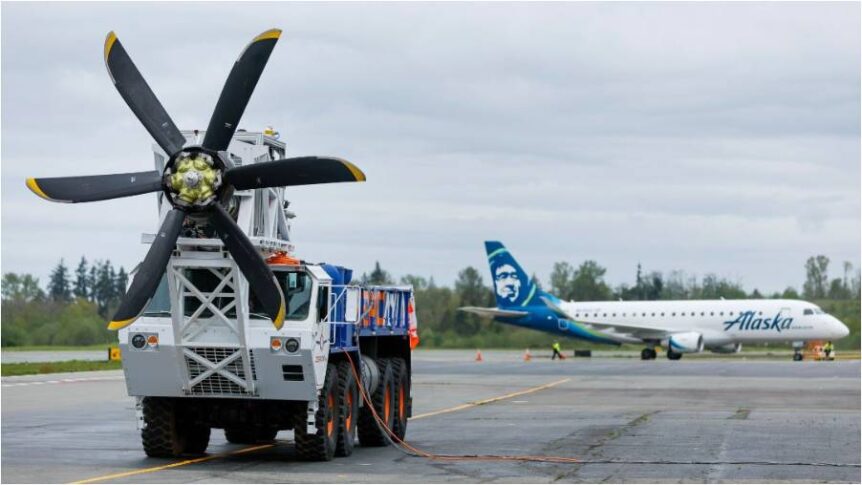ZeroAvia has taken delivery of a 76-seat Bombardier* Q400 airplane from Alaska Airlines. The craft could become a test bed for ZeroAvia’s modular HyperCore motors and hydrogen fuel systems. The Q400 will carry four times the number of passengers of the company’s current Dornier 228 twin-engine test aircraft – already having made five successful test flights.
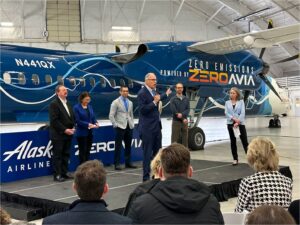
Washington Gov. Jay Inslee, U.S. Rep. Suzan DelBene and Snohomish County Executive Dave Somers join CEOs from Alaska and ZeroAvia to launch retrofitting of aircraft. Inslee said, “Our state has a rich history of leadership in aerospace and we’re proud to be at the center of a technological revolution in zero-emission flight. Through innovation and partnerships like the one demonstrated today, we can help write the next chapter of aviation history right here in Washington State.”
ZeroAvia proclaims, “The future of flight is renewable hydrogen,” and explains with a mission statement. “From 20 seat regional trips to over 100 seat long-distance flights, ZeroAvia enables scalable, sustainable aviation by replacing conventional engines with hydrogen-electric powertrains.”
Two Dorniers, one in the United Kingdom and one in Hollister, California, are undergoing test flights (five so far in the Cotswolds in England) or awaiting FAA approval for such flights in Hollister.
Acquiring the Bombardier brought a lot of attention to the Everett, Washington area recently, where ZeroAvia has a development center. Governor Jay Inslee came to inspect the project Q400 and prophecy about an increasingly closer future. Inslee Tweeted, “Zero-emissions passenger flight is within reach. Washington’s proving it. I stepped inside a Universal H2 -powered Dash 8-300 in Moses Lake a few weeks ago. And yesterday, ZeroAvia tested a hydrogen-electric engine for an AlaskaAir Q400. Clean innovation is taking off.”
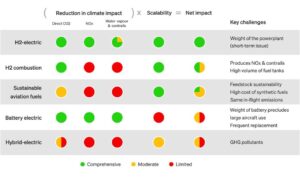
ZeroAvia’s comparison of competing powerrplant solutions of course favors ZeroAvia
ZeroAvia’s Twitter feed reported the test pilot and flight test engineer are happy with the results so far. the Dornier with a ZeroAvia ZA600. 600 kilowatt motor on the left side is performing in a more than a satisfactory way.
“Flight five in the books! As we approach the midway point in the first phase of our flight testing program for the retrofitted Dornier 228, we are happy to have achieved the maximum speed allowed under the permit to fly. During three loops of Cotswold Airport, test pilot Jon Killerby and flight test engineer James Yapp reached a top speed of 150 knots.” Each of the last three test flights [has] increased the craft’s top speed by 10 knots.
In the third flight, “The aircraft perform[ed] a leveled flight using only the ZA600 prototype engine. The test crew flew with zero thrust from the conventional turbine engine as the ZA600 entirely (on the left wing) powered the testbed aircraft as it circled Cotswold Airport.”
The bigger Q400 will need not only larger motors, but an H2 supply that can fuel those motors.
Val Miftakhov, founder and CEO of ZeroAvia, explains, “For the initial launch of the powertrain supporting smaller, up to 19-seat utility aircraft in 2025, we intend to stay with compressed gas [CGH2]. And then for another three to four years beyond that, we will use CGH2 in composite cylinders. We’re also looking at a number of conformable tank technologies from multiple manufacturers that are based on composites.”
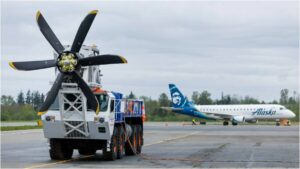
ZeroAvia 1.8 mW motor on rolling test stand
His comments to Composite World continue. “However, we think larger aircraft, and eventually all aircraft, will move to cryogenic LH2. Our first application of LH2 will be for the 40-80-seat regional turboprops like the DeHaviland of Canada Dash 8 and ATR families with customers like Alaska Airlines in 2027. We see the most promising approach is using composite tanks and we are working with a couple of partners on that already. We want to see H2 aircraft flying as far as jet fuel aircraft, possibly in 10-20 years, and I think cryogenic tanks using lightweight composites will be key to that.”
Conventionally powered Q400s require two Pratt & Whitney turbines of about 4,580 shaft horsepower. ZeroAvia is now testing it 1,8 megaWatt motors. We will safely assume that the 1.8 mW motor can be “stacked” to double its output – just about right for the requirement.
Since ZeroAvia and competitors like Universal Hydrogen are getting positive press and increasing attention in the market place, we will probably see continued growth and accelerating demonstrations of what is possible in green hydrogen and green flight.
On the Lighter Side
Gabriel DeVault, who oversaw development of the Zero Motorcycle motor and now the ZeroAvia powertrain, has the following request on his Facebook page:
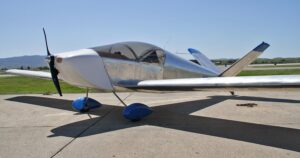
Sonex Exenos electric motorglider, as built by Gabriel DeVault. Several are under construction with one completed by Kitplanes editor Paul Dye
“I’m looking for a 50% partner for my electric Sonex Xenos motor glider. It doesn’t get flown enough and I’d like to share it with someone. It’s a unique aircraft that has been featured in Flying magazine and Kit Planes magazine.
“It’s got over 200 hours on it with not a single issue. This is absolutely the cheapest and cleanest way to have some fun flying around the Monterey Bay.”
*Originally DeHavilland of Canada, the company has gone through a series of ownership transitions.

